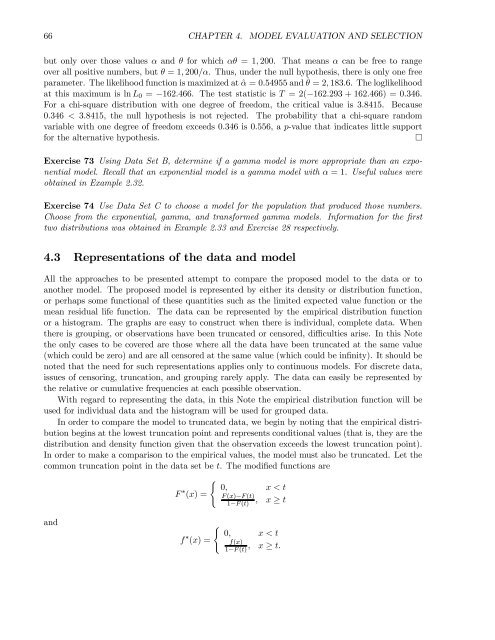Estimation, Evaluation, and Selection of Actuarial Models
Estimation, Evaluation, and Selection of Actuarial Models
Estimation, Evaluation, and Selection of Actuarial Models
You also want an ePaper? Increase the reach of your titles
YUMPU automatically turns print PDFs into web optimized ePapers that Google loves.
66 CHAPTER 4. MODEL EVALUATION AND SELECTION<br />
but only over those values α <strong>and</strong> θ for which αθ =1, 200. That means α canbefreetorange<br />
over all positive numbers, but θ =1, 200/α. Thus, under the null hypothesis, there is only one free<br />
parameter. The likelihood function is maximized at ˆα =0.54955 <strong>and</strong> ˆθ =2, 183.6. The loglikelihood<br />
at this maximum is ln L 0 = −162.466. The test statistic is T =2(−162.293 + 162.466) = 0.346.<br />
For a chi-square distribution with one degree <strong>of</strong> freedom, the critical value is 3.8415. Because<br />
0.346 < 3.8415, the null hypothesis is not rejected. The probability that a chi-square r<strong>and</strong>om<br />
variable with one degree <strong>of</strong> freedom exceeds 0.346 is 0.556, a p-value that indicates little support<br />
for the alternative hypothesis. ¤<br />
Exercise 73 Using Data Set B, determine if a gamma model is more appropriate than an exponential<br />
model. Recall that an exponential model is a gamma model with α =1.Usefulvalueswere<br />
obtained in Example 2.32.<br />
Exercise 74 Use Data Set C to choose a model for the population that produced those numbers.<br />
Choose from the exponential, gamma, <strong>and</strong> transformed gamma models. Information for the first<br />
two distributions was obtained in Example 2.33 <strong>and</strong> Exercise 28 respectively.<br />
4.3 Representations <strong>of</strong> the data <strong>and</strong> model<br />
All the approaches to be presented attempt to compare the proposed model to the data or to<br />
another model. The proposed model is represented by either its density or distribution function,<br />
or perhaps some functional <strong>of</strong> these quantities such as the limited expected value function or the<br />
mean residual life function. The data can be represented by the empirical distribution function<br />
or a histogram. The graphs are easy to construct when there is individual, complete data. When<br />
there is grouping, or observations have been truncated or censored, difficulties arise. In this Note<br />
the only cases to be covered are those where all the data have been truncated at the same value<br />
(which could be zero) <strong>and</strong> are all censored at the same value (which could be infinity). It should be<br />
noted that the need for such representations applies only to continuous models. For discrete data,<br />
issues <strong>of</strong> censoring, truncation, <strong>and</strong> grouping rarely apply. The data can easily be represented by<br />
the relative or cumulative frequencies at each possible observation.<br />
With regard to representing the data, in this Note the empirical distribution function will be<br />
used for individual data <strong>and</strong> the histogram will be used for grouped data.<br />
In order to compare the model to truncated data, we begin by noting that the empirical distribution<br />
begins at the lowest truncation point <strong>and</strong> represents conditional values (that is, they are the<br />
distribution <strong>and</strong> density function given that the observation exceeds the lowest truncation point).<br />
In order to make a comparison to the empirical values, the model must also be truncated. Let the<br />
common truncation point in the data set be t. The modified functions are<br />
(<br />
0, x < t<br />
F ∗ (x) = F (x)−F (t)<br />
1−F (t)<br />
, x ≥ t<br />
<strong>and</strong><br />
(<br />
0, x < t<br />
f ∗ (x) = f(x)<br />
1−F (t) , x ≥ t.
















